Analyzing the government’s multilateral measures to stabilize the foreign exchange market/maintain currency reserves along with timely supply

According to the economic reporter of Fars News Agency, the exchange rate volatility has been faced with various media speculations in recent days, market analysts believe that there are three reasonsGaneh Economic, political and diplomatic, along with a wide propaganda wave against the internal stability of our country caused the exchange rate to face a sudden growth and this may be a new side of the engineered combined war against our country.
On the other hand, some experts consider factors such as the failure of the capital market and the stagnation of the housing market and efforts to stabilize assets as the cause of liquidity migration and emotional behaviors. Applicants They know the currency, while the central bank has announced many times that emotional behavior and buying foreign currency as a way to preserve assets has always faced buyers with losses.
In recent days, the Central Bank has adopted special measures while emphasizing its presence in the foreign exchange market as a policy maker Necessary conditions to respond to foreign exchange needs Applicants and provides a balance to supply and demand, and in this regard, he implemented a special package.
in search for Due to the significant increase in the price of the dollar, the central bank has put measures such as the supply of foreign currency in the online system of the foreign exchange market, the issuance of coin certificates, the production of coins from melted gold with the cooperation of the private sector, and the provision of buying foreign currency from banks. It has been reviewed by economic experts and currency market activists.
Currency market analysts for They believe that the market maker’s solution to balance the market and restore stability to it is to strengthen the supply of currency and manage the demand side so that such real needs are covered in the currency market and any unrealistic needs are removed from this cycle.
* History of currency injection
The past experience of the actions of the past governments shows that they have always forced the central bank to increase the supply of currency, but the experience of the 90s has shown that the asset market does not reach equilibrium with the increase in supply, and if the increase in prices stops for a while with the increase in supply, by stopping or decreasing The intensity of the supply is on the rise again. In other words, the more assets are supplied to the market, the more thirsty the market will be.
A look at the past experience of the central bank in the past governments in the field of foreign exchange injection and the results of this policy shows that in 2019, the central bank injected 47 billion dollars of foreign currency into the market, but the price of foreign currency rose from around 1,000 tomans to 1,300 to 1,400 tomans and in 2011 with Decrease in the supply of currency, the price of currency went up to 3200 tomans.
In 1996, the central bank injected 18 billion dollars into the currency market, but the price of currency increased. In 1997, the government decided to supply 4,200 tomans of currency for all demands, and within a few months, billions of dollars of currency were poured into the market, but the price of currency in the market remained unchanged. increased, this is while the policy of the central bank in this period is to avoid the historical currency exchange of past governments and to control the market through the supply and demand system and to respond to the real currency needs in order to reduce the pressure on the people’s production and livelihood, and certainly the experiences The bitterness of the past will not be repeated.
* Currency supply in selected bank branches
Previously, in order to facilitate the supply of foreign currency, the central bank announced in an announcement that currency applicants can go to selected branches of the four National Banks of Iran, Saderat, Mellat and Tejarat to meet their needs, and now there are 40 branches. Some of these banks offer currency at an agreed rate.
This announcement shows that the market maker is looking to cover the real demands of the people, and in this direction, as Ali Saleh Abadi, the head of the central bank, also pointed out, it is important the most The point is to maintain the balance of the market while covering the basic needs of the people. This is one of the central bank’s solutions to create a balance between currency demand and supply volume.
* Any intervention currency exchange is not
after Release this The central bank’s circular to facilitate the allocation of quota currency to real applicants, some media titled currency exchange attributed to this circular, the choice of this title is while the central bank in its circular has emphasized the same previous method of allocating quota currency with the point that it has lined up bank exchanges to implement it.
As mentioned, this circular of the Central Bank was issued in order to eliminate the purchase queue for real applicants in front of the exchanges, while basically currency exchange It refers to the massive injection of currency in the market at a much lower rate than the free market, while quota currency is offered with a small difference from the free market. Therefore currency exchange Reading this policy from this point of view is also incorrect.
On the other hand, any intervention of the central bank in the foreign exchange market, assuming that the central bank enters the market and injects currency in the form of quota and travel currency, considering the rate close to the free market of quota currencies, this action of the central bank will have anti-inflationary effects.
On the one hand, this action causes the accumulation of liquidity from the market, and more importantly, it causes a decrease in the volume of the monetary base due to the decrease in the foreign assets of the Central Bank. Therefore, considering the anti-inflation effects of the central bank’s entry into the currency market, it is not logical to condemn this action
* Covering the people’s demand through the online currency system
The use of the online system of the foreign exchange market was another measure of the central bank to reduce the inflammation prevailing in the exchanges. The function of this system is such that people who are percentages buy foreign currency instead of going to the exchange in person through the online system that has been set up, they can send their requests online to the exchange of their choice and after authentication, go in person and get their currency receive
The internal manager of the integrated foreign exchange market states that the purpose of launching the online system of the integrated foreign exchange market is to help people and exchanges in the process of buying and selling foreign exchange.
Tawakli says: In the circular of the central bank, it was emphasized that all exchange offices are obliged to give priority to customers who purchased currency through this system, and it does not mean that they do not respond to customers in person.
In this regard, and in order to facilitate the response to the applicants in the exchanges, the POS transaction limit of the exchanges has been increased from 50 to 100 million Tomans. Every customer with a bank card in his name can make purchases up to 100 million tomans from exchanges.
* The balance between supply and demand in the remittance and banknote market, a market maker’s solution
According to the head of the central bank, the continuation of the supply in the Nima system until the market is balanced is the main approach of the market maker, and the supply of currency is carried out in the field of currencies that are favored by the private sector and have more demand, and the demand that exists for the real needs of the people. is covered.
The head of the central bank continues to emphasize the good reserves of the central bank of popular currencies and says: Currently, exporters are offering many currencies in the market by agreement, and there is no problem in providing banknotes and currency remittances.
Therefore, the preliminary monetary and credit statistics review report at the end stamp 1401 indicates the continuation of the decreasing trend of twelve-month liquidity growth this year, and this indicates that the reins of inflation will be curbed in the coming months.
The analysis of the twelve-month growth rate of liquidity shows that the growth rate of liquidity has decreased from 40.5% at the end of September 1400 during a downward trend to 37.5% at the end of September 1401. Statistical coverage (adding bank information Seal of economy In the monetary statistics, it is related due to the merger of the banks belonging to the armed forces in the Sepeh Bank, and if the increase in the aforementioned statistical coverage is not taken into account, the twelve-month liquidity growth at the end of September 1401 will decrease to 35.0%.
Therefore, the twelve-month growth of liquidity leading to the end of September 1401 (on a homogeneous basis) compared to the growth of the same period last year (40.5%), shows a decrease of 5.5 percentage points.
The growth of the monetary base in the twelve months ending in September 1401 was also 33.1%, while the growth rate of the monetary base at the end of September 1400 was 39.5%, according to this report and the measures taken during the last year. and review preliminary monetary and credit statistics at the end stamp 1401 indicates the continuation of the decreasing trend of twelve-month liquidity growth this year.
The volume of liquidity in August 2013 was equal to 640 thousand billion tomans, which reached 4 thousand 68 thousand billion tomans at the end of September 2014, and the amount of monetary base also increased from 96.3 thousand billion tomans in August 2013 to 519 thousand billion tomans at the end of September 2014. .
end of message/

